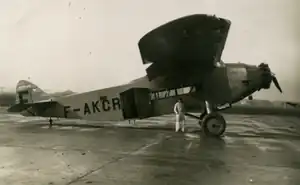Villiers 31
The Villiers 31 or Villiers 310 was a French eight passenger airliner of advanced construction. Owing to Villiers' financial failure, it was not developed.
| Villiers 31 | |
|---|---|
 | |
| Role | Eight passenger airliner |
| National origin | France |
| Manufacturer | Ateliers d'Aviation François Villiers |
| First flight | 1930 |
| Number built | 1 or 2 |
Design
Ateliers Villier's Type 31 was their last aircraft before they collapsed in 1931.[1] A single engine monoplane of mixed construction, it was also their only passenger aircraft.
It was a high wing aircraft; the wing had constant chord out to rounded tips and had a wooden structure with plywood skinning. The Villiers XXIV had been the first French aircraft maker to use Handley Page slats and the Villiers 26 reconnaissance seaplane used a combination of automatically opening slats on the leading edge in front of the ailerons and another set which the pilot opened as he lowered the flaps. The Type 31 had a similar combination of automatic and commanded slats.[2]
The Villiers 31 had a flat sided fuselage of rectangular cross-section behind the wing, built around a frame of chrome steel tubes and fabric covered.[2] It was the first aircraft to have an autogenically welded structure, that is welded without the use of a filler metal.[3] There was a 310 kW (420 hp) Gnome et Rhône 9Ab nine-cylinder radial engine in the nose, which some photographs show under a long-chord, close-fitting, circular cowling. Others show it uncowled. The two crew sat in a cockpit at the wing leading edge, the wing itself raised a little above the general fuselage line on a low fairing over the cabin, which seated eight and was lit by long strips of transparencies on each side. Access was via a rear starboard side door.[2]
Like the rest of the fuselage the empennage was steel framed and fabric covered. The tailplanes were mounted just below the top of the fuselage, each braced from below with a single strut and carrying a balanced elevator. A curved, deep, balanced rudder, mounted on a small fin and slightly pointed on top, worked in elevator cut-outs. The airliner had a fixed tailwheel undercarriage. The two mainwheels were mounted independently on V-struts from the lower fuselage with near-vertical oleo struts to the wing roots. The mainwheels had brakes and the tailwheel was steerable.[2]
Operational history
The exact date of the first flight of the Villiers 31 is not known, though all reports on it are from 1930.[2][3][4] On 13 March 1930 the Air Ministry concluded a contract for two Type 31s;[4] one of them (F-AKCR) was certainly built.[3]
Specifications
Data from L'année aéronautique 1930-31. p.61[2]
General characteristics
- Crew: two
- Capacity: eight
- Length: 14.10 m (46 ft 3 in)
- Wingspan: 19.20 m (63 ft 0 in)
- Height: 4.08 m (13 ft 5 in)
- Wing area: 56 m2 (600 sq ft)
- Empty weight: 1,950 kg (4,299 lb)
- Gross weight: 3,540 kg (7,804 lb)
- Fuel capacity: 400 kg (880 lb) fuel and oil
- Powerplant: 1 × Gnome et Rhône 9Ab 9-cylinder radial, 310 kW (420 hp) [4]
Performance
- Maximum speed: 180 km/h (110 mph, 97 kn) at sea level
- Cruise speed: 160 km/h (99 mph, 86 kn)
- Service ceiling: 3,500 m (11,500 ft)
- Time to altitude: 1 hr to ceiling
References
- Gunston, Bill (1993). World Encyclopaedia of Aircraft Manufacturers: from the pioneers to the present day. Sparkford, Somerset: Patrick Stephens Limited. p. 318. ISBN 9-781852-602055.
- Hirshauer, L.; Ch. Dolfus (1931). "Villiers 310". L'Année aéronautique. Paris: Dunod. 1930–31 (12): 61–2.
- "Les Tendences actuelle de la construction aéronautique". L'Aérophile-Salon: 92, 93, 96. 1930.
- "Rapport - Ministère de l'Air". Senat (124): 48. 13 March 1930.